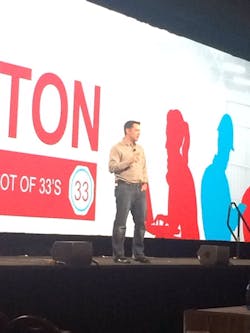This week, the Rockwell Automation TechED event took place in Orlando where 2,100 attendees representing 40 countries participated in about 170 sessions.
The workshops and discussions were designed to educate control engineers on the Rockwell product portfolio as it relates to overall technology trends. There were also opportunities to hear the technology deployment stories of their peers. And, this year, it seemed there was a bigger call-to-action related to the industry’s responsibility to encourage the next-generation of manufacturing engineers—which was specifically addressed during Dean Kamen’s keynote.
But while Kamen talked about how technology can inspire young minds, Rockwell Automation executives provided a sneak peak of what the future holds for today’s plant floor operators. Specifically, a self-aware high performance control architecture that includes smart connected services and a secure peer-to-peer mobile network complete with manufacturing “apps.”
On Monday, Rockwell Automation CTO Sujeet Chand kicked off the first day of the event with a high-level view of the company’s vision of the connected enterprise. “Our focus is on accelerating technology trends and how we can connect multiple silos of information to extract business value,” he said.
The trends Chand was referring to include the Industrial Internet of Things (IIoT), collaborative robots, machine learning, 3D printing, mobile devices, and even government-sponsored initiatives like the Smart Manufacturing Leadership Coalition and Industry 4.0. Rockwell’s Connected Enterprise allows information that typically sits in silos to be interconnected through design, operations and maintenance, Chand said.
“Today the Connected Enterprise is modular and secure, in the near future it will become predictive and optimized,” Chand said. To that end, this is evolving into a high-performance architecture. “And, long term we want the Connected Enterprise to be self adaptive and self healing.”
A self-aware asset understands its current status. An example being Rockwell Automation’s recently released self-tuning Kinetix servo drive that saves time in commissioning and in production by improving operations, as well as reducing downtime, energy costs and maintenance time.
“And when we launch the high performance control drives later this year, they will also predict the life of components and let the operator take control in a controlled fashion rather than having an unplanned failure result in downtime,” said Blake Moret, senior vice president of Control Products & Solutions, and Rockwell Automation’s new CEO, effective July 1, 2016.
For process industries specifically, Rockwell positions its PlantPAx digital control system (DCS) as an integrated architecture with plant-wide control that embraces the cloud, mobility and virtualization.
“In [our] modern DCS the network technology is based on standard unmodified Ethernet for the device level, peer-to-peer and information networks,” said John Genovesi, vice president of Rockwell Automation’s Information Solutions and Process Control Business. ”It’s the same network on the plant and the enterprise, which means there is an easy information flow and the flexibility to adapt to new technology.”
Another significant area of advancement within Rockwell is mobility. Last year, the company revealed an internal program called Project Stanton, that, the company said, was on a mission to find an easier way to collaborate on the plant floor. They started by looking at the smart phone device, which positions the person—a key element of productivity—as the edge component.
“The knowledge in workers' heads, and their experience and education, is equally as important as the data in the machine,” said Kyle Reissner, Rockwell’s mobility platform leader.
The set up uses data from devices and contextualized information with no changes to the existing control system architecture other than the addition of an app platform that is securely added to the network. Rockwell worked closely with Microsoft specifically on the area of connectivity, as the plant doesn’t always have Wi-Fi or cellular coverage.
“If we can’t go up to the cloud, let’s go sideways to the devices around us by using the radios built into the device to enable direct communication,” Reissner said.
The app platform includes eight initial modules: chat, incident, connect, pinboard, teamboard, device health, trend and knowledge-base. Using Thali, open source “peer web” connectivity technology, workers collaborate on a secure, synchronized peer-to-peer network using Wi-Fi or Bluetooth with no Internet access required.
While only a year and a half into development, the Project Stanton team is getting ready to release a preview of the app platform this summer, and welcomes user feedback to create a product that is not just innovative, but brings business value, too.
Want to get involved? Answer Project Stanton’s call to action at: www.33seconds.io
About the Author
Stephanie Neil
Editor-in-Chief, OEM Magazine

Leaders relevant to this article:
